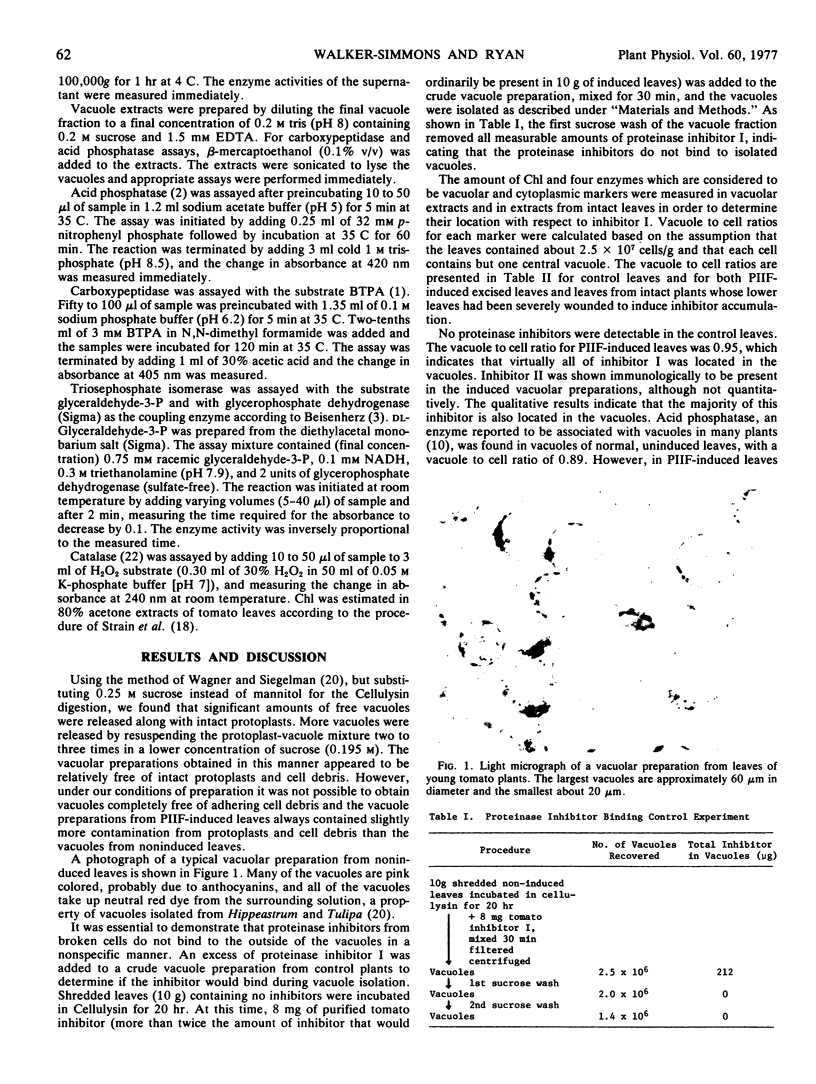Abstract
Proteinase inhibitor I has been identified and quantified in isolated vacuoles from tomato (Lycopersicon esculentum) leaves induced to accumulate inhibitors either by wounding or by supplying excised leaves with the wound hormone, proteinase inhibitor-inducing factor. Proteinase inhibitor II was also identified in the vacuoles but not quantified. Control vacuoles were prepared from unwounded plants that did not contain inhibitors. Vacuole to leaf cell ratios of inhibitors, chlorophyll, and several vacuolar and cytoplasmic enzymes were determined. The inhibitors were found almost entirely in the vacuoles. Acid phosphatase was located in control leaf vacuoles, but was found in both vacuoles and cytoplasm in induced leaves. Carboxypeptidase, induced by wounding, was found distributed between the vacuoles and cytoplasm of induced leaves. Low vacuole to leaf cell ratios of three cytoplasmic markers, triosephosphate isomerase, catalase, and chlorophyll, indicated that the isolated vacuoles were relatively free of intact protoplasts and cell debris.
Full text
PDF


Images in this article
Selected References
These references are in PubMed. This may not be the complete list of references from this article.
- Green T. R., Ryan C. A. Wound-Induced Proteinase Inhibitor in Plant Leaves: A Possible Defense Mechanism against Insects. Science. 1972 Feb 18;175(4023):776–777. doi: 10.1126/science.175.4023.776. [DOI] [PubMed] [Google Scholar]
- Green T. R., Ryan C. A. Wound-induced Proteinase Inhibitor in Tomato Leaves: Some Effects of Light and Temperature on the Wound Response. Plant Physiol. 1973 Jan;51(1):19–21. doi: 10.1104/pp.51.1.19. [DOI] [PMC free article] [PubMed] [Google Scholar]
- Gustafson G., Ryan C. A. Specificity of protein turnover in tomato leaves. Accumulation of proteinase inhibitors, induced with the wound hormone, PIIF. J Biol Chem. 1976 Nov 25;251(22):7004–7010. [PubMed] [Google Scholar]
- Jackson A. O., Larkins B. A. Influence of Ionic Strength, pH, and Chelation of Divalent Metals on Isolation of Polyribosomes from Tobacco Leaves. Plant Physiol. 1976 Jan;57(1):5–10. doi: 10.1104/pp.57.1.5. [DOI] [PMC free article] [PubMed] [Google Scholar]
- Ryan C. A. Assay and Biochemical Properties of the Proteinase Inhibitor-inducing Factor, a Wound Hormone. Plant Physiol. 1974 Sep;54(3):328–332. doi: 10.1104/pp.54.3.328. [DOI] [PMC free article] [PubMed] [Google Scholar]
- Ryan C. A. Quantitative determination of soluble cellular proteins by radial diffusion in agar gels containing antibodies. Anal Biochem. 1967 Jun;19(3):434–440. doi: 10.1016/0003-2697(67)90233-3. [DOI] [PubMed] [Google Scholar]
- Shepard J. F., Totten R. E. Isolation and Regeneration of Tobacco Mesophyll Cell Protoplasts under Low Osmotic Conditions. Plant Physiol. 1975 Apr;55(4):689–694. doi: 10.1104/pp.55.4.689. [DOI] [PMC free article] [PubMed] [Google Scholar]
- Strobel G. A., Hess W. M. Evidence for the presence of the toxin-binding protein on the plasma membrane of sugarcane cells. Proc Natl Acad Sci U S A. 1974 Apr;71(4):1413–1417. doi: 10.1073/pnas.71.4.1413. [DOI] [PMC free article] [PubMed] [Google Scholar]
- Walker-Simmons M., Ryan C. A. Wound-induced Accumulation of Trypsin Inhibitor Activities in Plant Leaves: Survey of Several Plant Genera. Plant Physiol. 1977 Mar;59(3):437–439. doi: 10.1104/pp.59.3.437. [DOI] [PMC free article] [PubMed] [Google Scholar]



